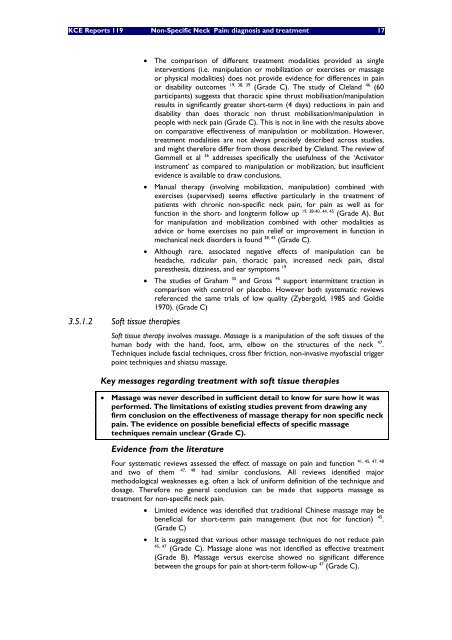Non-specific neck pain: diagnosis and treatment - KCE
Non-specific neck pain: diagnosis and treatment - KCE
Non-specific neck pain: diagnosis and treatment - KCE
Create successful ePaper yourself
Turn your PDF publications into a flip-book with our unique Google optimized e-Paper software.
<strong>KCE</strong> Reports 119 <strong>Non</strong>-Specific Neck Pain: <strong>diagnosis</strong> <strong>and</strong> <strong>treatment</strong> 17<br />
• The comparison of different <strong>treatment</strong> modalities provided as single<br />
interventions (i.e. manipulation or mobilization or exercises or massage<br />
or physical modalities) does not provide evidence for differences in <strong>pain</strong><br />
or disability outcomes 19, 38, 39 (Grade C). The study of Clel<strong>and</strong> 46 (60<br />
participants) suggests that thoracic spine thrust mobilisation/manipulation<br />
results in significantly greater short-term (4 days) reductions in <strong>pain</strong> <strong>and</strong><br />
disability than does thoracic non thrust mobilisation/manipulation in<br />
people with <strong>neck</strong> <strong>pain</strong> (Grade C). This is not in line with the results above<br />
on comparative effectiveness of manipulation or mobilization. However,<br />
<strong>treatment</strong> modalities are not always precisely described across studies,<br />
<strong>and</strong> might therefore differ from those described by Clel<strong>and</strong>. The review of<br />
Gemmell et al 36 addresses <strong>specific</strong>ally the usefulness of the ‘Activator<br />
instrument’ as compared to manipulation or mobilization, but insufficient<br />
evidence is available to draw conclusions.<br />
• Manual therapy (involving mobilization, manipulation) combined with<br />
exercises (supervised) seems effective particularly in the <strong>treatment</strong> of<br />
patients with chronic non-<strong>specific</strong> <strong>neck</strong> <strong>pain</strong>, for <strong>pain</strong> as well as for<br />
function in the short- <strong>and</strong> longterm follow up 19, 38-40, 44, 45 (Grade A). But<br />
for manipulation <strong>and</strong> mobilization combined with other modalities as<br />
advice or home exercises no <strong>pain</strong> relief or improvement in function in<br />
mechanical <strong>neck</strong> disorders is found 38, 45 (Grade C).<br />
• Although rare, associated negative effects of manipulation can be<br />
headache, radicular <strong>pain</strong>, thoracic <strong>pain</strong>, increased <strong>neck</strong> <strong>pain</strong>, distal<br />
paresthesia, dizziness, <strong>and</strong> ear symptoms 19<br />
• The studies of Graham 35 <strong>and</strong> Gross 45 support intermittent traction in<br />
comparison with control or placebo. However both systematic reviews<br />
referenced the same trials of low quality (Zybergold, 1985 <strong>and</strong> Goldie<br />
1970). (Grade C)<br />
3.5.1.2 Soft tissue therapies<br />
Soft tissue therapy involves massage. Massage is a manipulation of the soft tissues of the<br />
human body with the h<strong>and</strong>, foot, arm, elbow on the structures of the <strong>neck</strong> 47 .<br />
Techniques include fascial techniques, cross fiber friction, non-invasive myofascial trigger<br />
point techniques <strong>and</strong> shiatsu massage.<br />
Key messages regarding <strong>treatment</strong> with soft tissue therapies<br />
• Massage was never described in sufficient detail to know for sure how it was<br />
performed. The limitations of existing studies prevent from drawing any<br />
firm conclusion on the effectiveness of massage therapy for non <strong>specific</strong> <strong>neck</strong><br />
<strong>pain</strong>. The evidence on possible beneficial effects of <strong>specific</strong> massage<br />
techniques remain unclear (Grade C).<br />
Evidence from the literature<br />
41, 45, 47, 48<br />
Four systematic reviews assessed the effect of massage on <strong>pain</strong> <strong>and</strong> function<br />
<strong>and</strong> two of them 47, 48 had similar conclusions. All reviews identified major<br />
methodological weaknesses e.g. often a lack of uniform definition of the technique <strong>and</strong><br />
dosage. Therefore no general conclusion can be made that supports massage as<br />
<strong>treatment</strong> for non-<strong>specific</strong> <strong>neck</strong> <strong>pain</strong>.<br />
• Limited evidence was identified that traditional Chinese massage may be<br />
beneficial for short-term <strong>pain</strong> management (but not for function) 45 .<br />
(Grade C)<br />
• It is suggested that various other massage techniques do not reduce <strong>pain</strong><br />
45, 47<br />
(Grade C). Massage alone was not identified as effective <strong>treatment</strong><br />
(Grade B). Massage versus exercise showed no significant difference<br />
between the groups for <strong>pain</strong> at short-term follow-up 47 (Grade C).

















